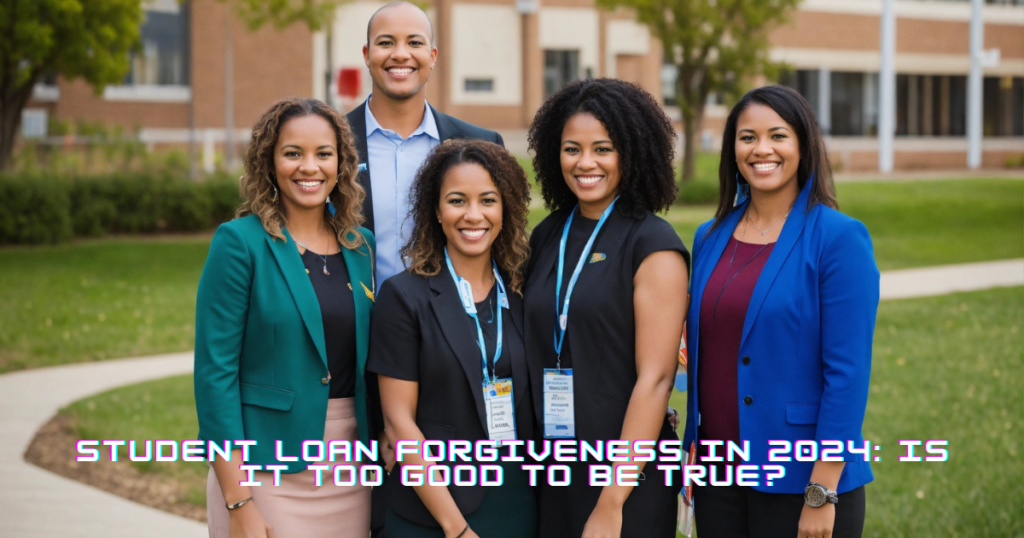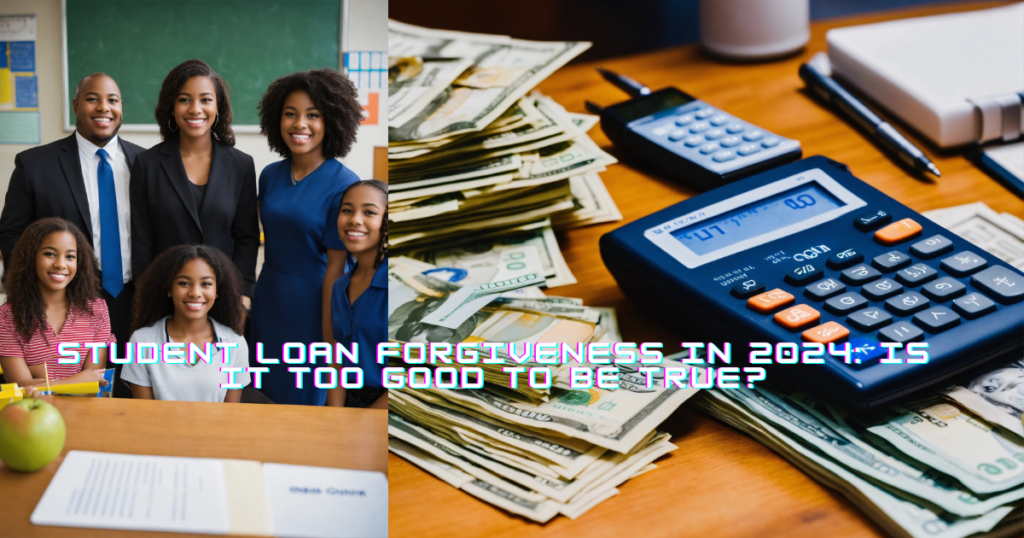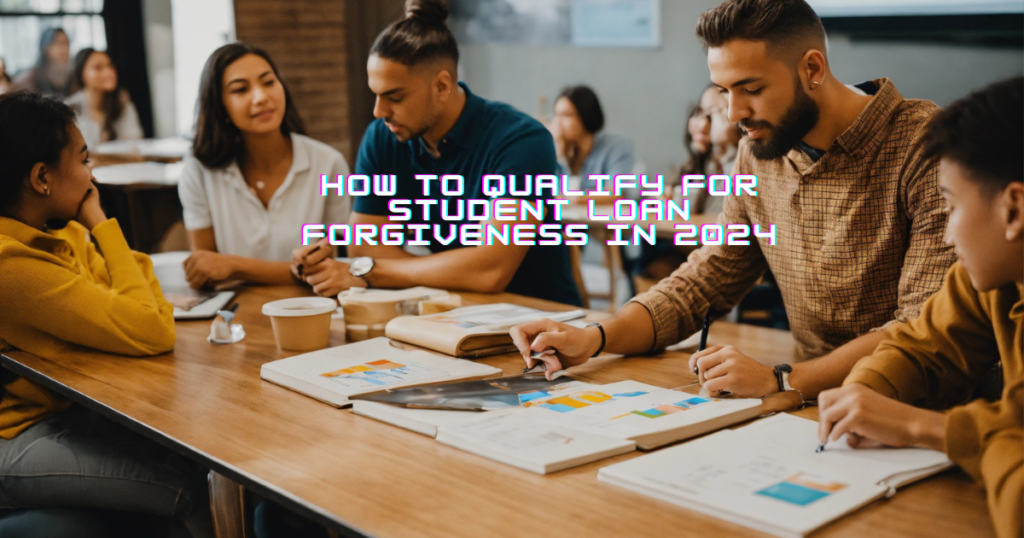Student loan forgiveness is a program that can help you reduce or eliminate your student loan debt if you meet certain criteria. There are different types of student loan forgiveness programs, such as Public Service Loan Forgiveness (PSLF), Teacher Loan Forgiveness, or Income-Driven Repayment (IDR) Forgiveness. Each program has its own eligibility requirements, benefits and application process.
In this post, I will explain the general steps that you can follow to explore your options and apply for student loan forgiveness. However, keep in mind that this is not a definitive guide, and you should always consult the official websites of the programs or your loan servicer for more details and updates.

You Need to Know About Student Loan Forgiveness in 2024
- 1: Identify your federal student loans and loan servicer
- 2: Check your eligibility for federal student loan forgiveness programs
- 3: Apply for PSLF if you are eligible
- 4: Apply for Teacher Loan Forgiveness if you are eligible
- 5: Apply for an IDR plan if you are eligible
- 6: Make monthly payments under an IDR plan
- 7: Apply for IDR Forgiveness after making the required number of payments
- Explore other sources of student loan forgiveness
- 9: Understand the terms and conditions of your student loan forgiveness program
- 10: Contact your loan servicer for assistance or complaints
- Conclusion: Student Loan Forgiveness
- FAQs: People also ask
- Disclaimer
1: Identify your federal student loans and loan servicer
The first step is to identify what types of federal student loans you have and who your loan servicer is. Your loan servicer is the company that handles the billing and other services of your loans. You can use the [National Student Loan Data System] to find this information. You will require your FSA ID to log in.
2: Check your eligibility for federal student loan forgiveness programs
The next step is to check if you qualify for any of the federal student loan forgiveness programs. The most common programs are:
- Public Service Loan Forgiveness (PSLF): This program forgives the outstanding balance of your Direct Loans after you make 120 qualifying monthly installments while working full-time for a qualifying employer, such as a government agency or a non-profit organization.
- Teacher Loan Forgiveness: This program forgives up to $17.5 K of your Direct or FFEL Loans after teaching full-time for 5 complete and consecutive academic years in a low-income school or educational service agency, and meets other requirements.
- Income-Driven Repayment (IDR) Forgiveness: This program forgives the remaining balance of your Direct Loans after you make monthly payments based on your income and family size for 20 or 25 years, depending on the plan and the type of loans you have.
You can use the [PSLF Help Tool] or the [Loan Simulator] to see which programs you may be eligible for and compare their benefits.
3: Apply for PSLF if you are eligible
If you are eligible for PSLF, you need to work full-time for a qualifying employer, such as a government agency or a non-profit organization, and make 120 qualifying monthly payments on your Direct Loans. A qualifying payment is one that is made:
- After Oct. 1, 2007
- Under a qualifying repayment plan (generally an IDR plan)
- For the full amount due as shown on your bill
- Not later than 15 days after due date
- While you are employed full-time basis by a qualifying employer
You also need to submit the [Employment Certification Form] annually or whenever you change employers to track your progress. You can use the [PSLF Help Tool] to generate the form and find out where to send it.
After you make your 120th qualifying payment, you can apply for forgiveness by submitting the [PSLF Application for Forgiveness] to Fed Loan Servicing, the PSLF servicer.
4: Apply for Teacher Loan Forgiveness if you are eligible
If you are eligible for Teacher Loan Forgiveness, you need to teach full-time for five complete and consecutive academic years in a low-income school or educational service agency, and meet other requirements. You can find the list of qualifying schools and agencies on the [Teacher Cancellation Low Income Directory].
To be considered a full-time teacher, you must meet the standard of your state or employer. You must also:
- Have a bachelor’s degree or higher
- Be a highly qualified teacher, which means you have obtained full state certification or passed the state teacher licensing exam and hold a license to teach
- Not have had an outstanding balance on Direct or FFEL Loans as of Oct. 1, 1998, or on the date you obtained a Direct or FFEL Loan after Oct. 1, 1998
The amount of forgiveness you can receive is based on the subject area you teach. You can receive up to $17.5K if you teach:
- Mathematics or science at the secondary level
- Special education at any level
You can receive up to $5,000 if you teach any other subject at any level.
You can apply for forgiveness after completing the required teaching service by submitting the [Teacher Loan Forgiveness Application] to your loan servicer.
5: Apply for an IDR plan if you are eligible
If you are eligible for IDR Forgiveness, you need to enroll in one of the four IDR plans: Saving on a Valuable Education (SAVE) Plan, Pay As You Earn (PAYE) Plan, Income-Based Repayment (IBR) Plan, or Income-Contingent Repayment (ICR) Plan. Each plan has its own eligibility criteria, payment calculation, and forgiveness period. One can use the [Loan Simulator] to see which plan is best for you and how much you can save.
You can apply for an IDR plan online at [studentaid.gov] or by submitting a paper application to your loan servicer. You will need to provide information about your income and family size, and you may need to submit supporting documents, such as your tax return or pay stubs.

6: Make monthly payments under an IDR plan
Under an IDR plan, you need to make monthly payments based on your income and family size for 20 or 25 years, depending on the plan and the type of loans you have. Your payment amount may change each year as your income and family size change. You also need to recertify your income and family size every year to keep your payments affordable. You can do this online at [studentaid.gov] or by submitting a paper form to your loan servicer.
If your payment amount is less than the interest that accrues on your loans, your unpaid interest may be capitalized (added to your principal balance) at certain times, such as when you leave the plan or fail to recertify your income. This may increase the amount of interest you pay over time.
7: Apply for IDR Forgiveness after making the required number of payments
If you have any remaining loan balance after making the required number of payments under an IDR plan, it will be forgiven. You do not need to submit a separate application for forgiveness, as your loan servicer will notify you when you are nearing the end of your repayment period and confirm your eligibility.
However, you may have to pay taxes on the forgiven amount, unless you qualify for tax exemption. The IRS considers forgiven student loans as taxable income, and you will receive a Form 1099-C from your loan servicer. You should consult a tax professional to determine your tax liability and plan accordingly.
Explore other sources of student loan forgiveness
If you are not eligible for any of the federal student loan forgiveness programs, you may still be able to get help from other sources, such as state or local programs, employer assistance, or military service. Some examples are:
- State or local programs: Some states or local governments offer student loan forgiveness or repayment assistance to residents who work in certain fields or areas, such as health care, education, or public service. You can search for these opportunities online or contact your state or local agencies for more information.
- Employer assistance: Some employers offer student loan forgiveness or repayment assistance to their employees as part of their benefits package. You can check with your human resources department or your employer’s website to see if they offer this option and what the terms and conditions are.
- Military service: Some branches of the military offer student loan forgiveness or repayment assistance to their members or veterans as part of their service benefits. You can contact your branch of service or the [Department of Veterans Affairs] to see if you qualify and how to apply.
9: Understand the terms and conditions of your student loan forgiveness program
Before you apply for any student loan forgiveness program, make sure you understand the terms and conditions, such as the eligibility requirements, the application process, the amount and timing of forgiveness, and the tax implications. You can find more details on the official websites of the programs or by contacting your loan servicer.
Some important things to keep always in mind are:
- You must continue to make your monthly payments until your forgiveness is approved and processed. Missing or late payments may disqualify you from forgiveness or delay your forgiveness.
- You must notify your loan servicer of any changes in your situation that may affect your eligibility or payment amount. For example, if you change your employer, income, or family size, you must inform your loan servicer as soon as possible and submit any required documents.
- You must keep track of your student loan payments and balances, and keep copies of any documents related to your forgiveness application. For example, you should keep your payment receipts, employment certification forms, tax returns, and correspondence with your loan servicer. You may need to provide proof of your eligibility or payment history if there is any dispute or error.
10: Contact your loan servicer for assistance or complaints
If you have any questions or issues regarding your student loan forgiveness, you can contact your loan servicer for assistance. Your loan servicer is the company that handles the billing and other services of your loans. You can find their contact information on your monthly billing statement or on the [Federal Student Aid website]
Conclusion: Student Loan Forgiveness
Navigating the landscape of student loan forgiveness demands diligence, proactive communication, and a deep understanding of the specific programs. By following these 10 steps, you can embark on a journey towards financial freedom and relief from the shackles of student debt. Always stay informed, consult reliable sources, and take charge of your student loan forgiveness journey. Your path to a debt-free future begins with the first step – understanding the process.

FAQs: People also ask
Why did my student loans not get forgiven?
There could be several reasons why your student loans were not forgiven. Some common reasons include:
- Ineligibility: If you did not meet the specific requirements of the forgiveness program you applied for, your loans may not be forgiven. Each program has its own set of criteria, and failure to fulfill them could result in non-approval.
- Incomplete Payments: For programs like Public Service Loan Forgiveness (PSLF), ensuring 120 qualifying monthly payments is crucial. Any missed or incomplete payments may hinder the forgiveness process.
- Incorrect Repayment Plan: If you are on the wrong repayment plan, it might not align with the requirements for forgiveness. Ensure you are enrolled in the correct plan for the program you are pursuing.
- Documentation Issues: Failure to submit necessary documents or inaccuracies in the provided information can also lead to non-approval.
It’s advisable to review the specific reasons for denial and consult with your loan servicer or the forgiveness program’s official channels for clarification.
Are student loans still on hold?
The status of student loan forbearance or suspension can change based on government decisions and policies. As of my last knowledge update in January 2022, the situation might have evolved. To get the latest information, check official sources such as the Department of Education’s website, your loan servicer, or reliable news outlets for updates on the current status of student loan repayment and potential holds.
Should I pay off my student loans or wait for forgiveness?
This decision depends on various factors, including the type of loans you have, your financial situation, and the forgiveness program you are considering. Here are some considerations:
- Interest Accumulation: While waiting for forgiveness, interest may accrue, increasing the overall amount you owe. Consider the impact of interest on your total repayment. Program Reliability: Some forgiveness programs, like Public Service Loan Forgiveness (PSLF), have specific criteria and are more established, making them reliable options. Others may have uncertainties.Financial Stability: If you have the means to comfortably pay off your loans without jeopardizing your financial stability, it might be a viable option, especially if you’re uncertain about forgiveness eligibility.
- Consultation: Seeking advice from financial professionals or student loan experts can help you make an informed decision based on your unique circumstances.
Disclaimer
This article has been created on the basis of internal data, information available publicly, and other reliable sources to be believed. The article may also include information which are the personal views/opinions of the authors. The information included in this article is for general, educational, and awareness purposes only and is not a full disclosure of every material fact.
All the information on this website i.e. World Virtual CFO – is published in good faith and for general information purposes only. World Virtual CFO does not make any warranties about the completeness, reliability, and accuracy of this information. These are my views for only information purposes. Any action you take upon the information you find on this website (World Virtual CFO), is strictly at your own risk. World Virtual CFO will not be liable for any losses and/or damages in connection with using our website. For details please refer to our disclaimer page.
Dr. Dinesh Sharma is an award-winning CFO and AI strategist with over two decades of experience in financial leadership, digital transformation, and business optimization. As the founder of multiple niche platforms—including WorldVirtualCFO.com—he empowers professionals and organizations with strategic insights, system structuring, and innovative tools for sustainable growth. His blogs and e-books blend precision with vision, making complex financial and technological concepts accessible and actionable.